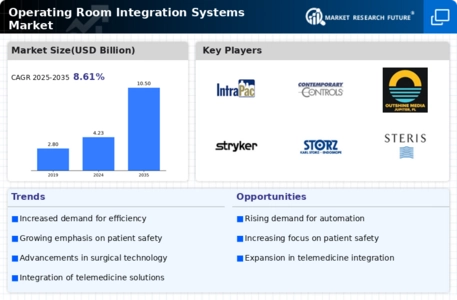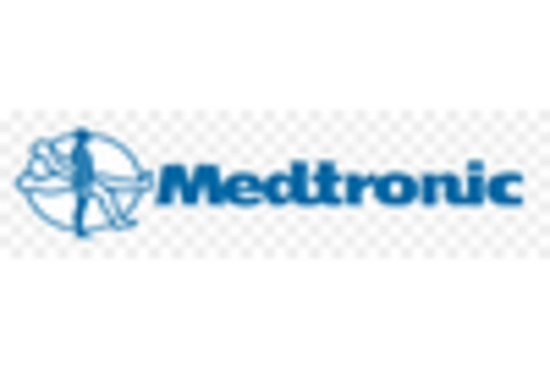Hardware
Software
Services
Surgical Procedures
Endoscopic Procedures
Diagnostic Procedures
Hospitals
Surgical Centers
Specialty Clinics
Audio Visual Integration
Data Management Systems
Communication Systems
North America
Europe
South America
Asia Pacific
Middle East and Africa
North America Outlook (USD Billion, 2019-2035)
North America Operating Room Integration Systems Market by Component Type
Hardware
Software
Services
North America Operating Room Integration Systems Market by Application Type
Surgical Procedures
Endoscopic Procedures
Diagnostic Procedures
North America Operating Room Integration Systems Market by End User Type
Hospitals
Surgical Centers
Specialty Clinics
North America Operating Room Integration Systems Market by Technology Type
Audio Visual Integration
Data Management Systems
Communication Systems
North America Operating Room Integration Systems Market by Regional Type
US
Canada
US Outlook (USD Billion, 2019-2035)
US Operating Room Integration Systems Market by Component Type
Hardware
Software
Services
US Operating Room Integration Systems Market by Application Type
Surgical Procedures
Endoscopic Procedures
Diagnostic Procedures
US Operating Room Integration Systems Market by End User Type
Hospitals
Surgical Centers
Specialty Clinics
US Operating Room Integration Systems Market by Technology Type
Audio Visual Integration
Data Management Systems
Communication Systems
CANADA Outlook (USD Billion, 2019-2035)
CANADA Operating Room Integration Systems Market by Component Type
Hardware
Software
Services
CANADA Operating Room Integration Systems Market by Application Type
Surgical Procedures
Endoscopic Procedures
Diagnostic Procedures
CANADA Operating Room Integration Systems Market by End User Type
Hospitals
Surgical Centers
Specialty Clinics
CANADA Operating Room Integration Systems Market by Technology Type
Audio Visual Integration
Data Management Systems
Communication Systems
Europe Outlook (USD Billion, 2019-2035)
Europe Operating Room Integration Systems Market by Component Type
Hardware
Software
Services
Europe Operating Room Integration Systems Market by Application Type
Surgical Procedures
Endoscopic Procedures
Diagnostic Procedures
Europe Operating Room Integration Systems Market by End User Type
Hospitals
Surgical Centers
Specialty Clinics
Europe Operating Room Integration Systems Market by Technology Type
Audio Visual Integration
Data Management Systems
Communication Systems
Europe Operating Room Integration Systems Market by Regional Type
Germany
UK
France
Russia
Italy
Spain
Rest of Europe
GERMANY Outlook (USD Billion, 2019-2035)
GERMANY Operating Room Integration Systems Market by Component Type
Hardware
Software
Services
GERMANY Operating Room Integration Systems Market by Application Type
Surgical Procedures
Endoscopic Procedures
Diagnostic Procedures
GERMANY Operating Room Integration Systems Market by End User Type
Hospitals
Surgical Centers
Specialty Clinics
GERMANY Operating Room Integration Systems Market by Technology Type
Audio Visual Integration
Data Management Systems
Communication Systems
UK Outlook (USD Billion, 2019-2035)
UK Operating Room Integration Systems Market by Component Type
Hardware
Software
Services
UK Operating Room Integration Systems Market by Application Type
Surgical Procedures
Endoscopic Procedures
Diagnostic Procedures
UK Operating Room Integration Systems Market by End User Type
Hospitals
Surgical Centers
Specialty Clinics
UK Operating Room Integration Systems Market by Technology Type
Audio Visual Integration
Data Management Systems
Communication Systems
FRANCE Outlook (USD Billion, 2019-2035)
FRANCE Operating Room Integration Systems Market by Component Type
Hardware
Software
Services
FRANCE Operating Room Integration Systems Market by Application Type
Surgical Procedures
Endoscopic Procedures
Diagnostic Procedures
FRANCE Operating Room Integration Systems Market by End User Type
Hospitals
Surgical Centers
Specialty Clinics
FRANCE Operating Room Integration Systems Market by Technology Type
Audio Visual Integration
Data Management Systems
Communication Systems
RUSSIA Outlook (USD Billion, 2019-2035)
RUSSIA Operating Room Integration Systems Market by Component Type
Hardware
Software
Services
RUSSIA Operating Room Integration Systems Market by Application Type
Surgical Procedures
Endoscopic Procedures
Diagnostic Procedures
RUSSIA Operating Room Integration Systems Market by End User Type
Hospitals
Surgical Centers
Specialty Clinics
RUSSIA Operating Room Integration Systems Market by Technology Type
Audio Visual Integration
Data Management Systems
Communication Systems
ITALY Outlook (USD Billion, 2019-2035)
ITALY Operating Room Integration Systems Market by Component Type
Hardware
Software
Services
ITALY Operating Room Integration Systems Market by Application Type
Surgical Procedures
Endoscopic Procedures
Diagnostic Procedures
ITALY Operating Room Integration Systems Market by End User Type
Hospitals
Surgical Centers
Specialty Clinics
ITALY Operating Room Integration Systems Market by Technology Type
Audio Visual Integration
Data Management Systems
Communication Systems
SPAIN Outlook (USD Billion, 2019-2035)
SPAIN Operating Room Integration Systems Market by Component Type
Hardware
Software
Services
SPAIN Operating Room Integration Systems Market by Application Type
Surgical Procedures
Endoscopic Procedures
Diagnostic Procedures
SPAIN Operating Room Integration Systems Market by End User Type
Hospitals
Surgical Centers
Specialty Clinics
SPAIN Operating Room Integration Systems Market by Technology Type
Audio Visual Integration
Data Management Systems
Communication Systems
REST OF EUROPE Outlook (USD Billion, 2019-2035)
REST OF EUROPE Operating Room Integration Systems Market by Component Type
Hardware
Software
Services
REST OF EUROPE Operating Room Integration Systems Market by Application Type
Surgical Procedures
Endoscopic Procedures
Diagnostic Procedures
REST OF EUROPE Operating Room Integration Systems Market by End User Type
Hospitals
Surgical Centers
Specialty Clinics
REST OF EUROPE Operating Room Integration Systems Market by Technology Type
Audio Visual Integration
Data Management Systems
Communication Systems
APAC Outlook (USD Billion, 2019-2035)
APAC Operating Room Integration Systems Market by Component Type
Hardware
Software
Services
APAC Operating Room Integration Systems Market by Application Type
Surgical Procedures
Endoscopic Procedures
Diagnostic Procedures
APAC Operating Room Integration Systems Market by End User Type
Hospitals
Surgical Centers
Specialty Clinics
APAC Operating Room Integration Systems Market by Technology Type
Audio Visual Integration
Data Management Systems
Communication Systems
APAC Operating Room Integration Systems Market by Regional Type
China
India
Japan
South Korea
Malaysia
Thailand
Indonesia
Rest of APAC
CHINA Outlook (USD Billion, 2019-2035)
CHINA Operating Room Integration Systems Market by Component Type
Hardware
Software
Services
CHINA Operating Room Integration Systems Market by Application Type
Surgical Procedures
Endoscopic Procedures
Diagnostic Procedures
CHINA Operating Room Integration Systems Market by End User Type
Hospitals
Surgical Centers
Specialty Clinics
CHINA Operating Room Integration Systems Market by Technology Type
Audio Visual Integration
Data Management Systems
Communication Systems
INDIA Outlook (USD Billion, 2019-2035)
INDIA Operating Room Integration Systems Market by Component Type
Hardware
Software
Services
INDIA Operating Room Integration Systems Market by Application Type
Surgical Procedures
Endoscopic Procedures
Diagnostic Procedures
INDIA Operating Room Integration Systems Market by End User Type
Hospitals
Surgical Centers
Specialty Clinics
INDIA Operating Room Integration Systems Market by Technology Type
Audio Visual Integration
Data Management Systems
Communication Systems
JAPAN Outlook (USD Billion, 2019-2035)
JAPAN Operating Room Integration Systems Market by Component Type
Hardware
Software
Services
JAPAN Operating Room Integration Systems Market by Application Type
Surgical Procedures
Endoscopic Procedures
Diagnostic Procedures
JAPAN Operating Room Integration Systems Market by End User Type
Hospitals
Surgical Centers
Specialty Clinics
JAPAN Operating Room Integration Systems Market by Technology Type
Audio Visual Integration
Data Management Systems
Communication Systems
SOUTH KOREA Outlook (USD Billion, 2019-2035)
SOUTH KOREA Operating Room Integration Systems Market by Component Type
Hardware
Software
Services
SOUTH KOREA Operating Room Integration Systems Market by Application Type
Surgical Procedures
Endoscopic Procedures
Diagnostic Procedures
SOUTH KOREA Operating Room Integration Systems Market by End User Type
Hospitals
Surgical Centers
Specialty Clinics
SOUTH KOREA Operating Room Integration Systems Market by Technology Type
Audio Visual Integration
Data Management Systems
Communication Systems
MALAYSIA Outlook (USD Billion, 2019-2035)
MALAYSIA Operating Room Integration Systems Market by Component Type
Hardware
Software
Services
MALAYSIA Operating Room Integration Systems Market by Application Type
Surgical Procedures
Endoscopic Procedures
Diagnostic Procedures
MALAYSIA Operating Room Integration Systems Market by End User Type
Hospitals
Surgical Centers
Specialty Clinics
MALAYSIA Operating Room Integration Systems Market by Technology Type
Audio Visual Integration
Data Management Systems
Communication Systems
THAILAND Outlook (USD Billion, 2019-2035)
THAILAND Operating Room Integration Systems Market by Component Type
Hardware
Software
Services
THAILAND Operating Room Integration Systems Market by Application Type
Surgical Procedures
Endoscopic Procedures
Diagnostic Procedures
THAILAND Operating Room Integration Systems Market by End User Type
Hospitals
Surgical Centers
Specialty Clinics
THAILAND Operating Room Integration Systems Market by Technology Type
Audio Visual Integration
Data Management Systems
Communication Systems
INDONESIA Outlook (USD Billion, 2019-2035)
INDONESIA Operating Room Integration Systems Market by Component Type
Hardware
Software
Services
INDONESIA Operating Room Integration Systems Market by Application Type
Surgical Procedures
Endoscopic Procedures
Diagnostic Procedures
INDONESIA Operating Room Integration Systems Market by End User Type
Hospitals
Surgical Centers
Specialty Clinics
INDONESIA Operating Room Integration Systems Market by Technology Type
Audio Visual Integration
Data Management Systems
Communication Systems
REST OF APAC Outlook (USD Billion, 2019-2035)
REST OF APAC Operating Room Integration Systems Market by Component Type
Hardware
Software
Services
REST OF APAC Operating Room Integration Systems Market by Application Type
Surgical Procedures
Endoscopic Procedures
Diagnostic Procedures
REST OF APAC Operating Room Integration Systems Market by End User Type
Hospitals
Surgical Centers
Specialty Clinics
REST OF APAC Operating Room Integration Systems Market by Technology Type
Audio Visual Integration
Data Management Systems
Communication Systems
South America Outlook (USD Billion, 2019-2035)
South America Operating Room Integration Systems Market by Component Type
Hardware
Software
Services
South America Operating Room Integration Systems Market by Application Type
Surgical Procedures
Endoscopic Procedures
Diagnostic Procedures
South America Operating Room Integration Systems Market by End User Type
Hospitals
Surgical Centers
Specialty Clinics
South America Operating Room Integration Systems Market by Technology Type
Audio Visual Integration
Data Management Systems
Communication Systems
South America Operating Room Integration Systems Market by Regional Type
Brazil
Mexico
Argentina
Rest of South America
BRAZIL Outlook (USD Billion, 2019-2035)
BRAZIL Operating Room Integration Systems Market by Component Type
Hardware
Software
Services
BRAZIL Operating Room Integration Systems Market by Application Type
Surgical Procedures
Endoscopic Procedures
Diagnostic Procedures
BRAZIL Operating Room Integration Systems Market by End User Type
Hospitals
Surgical Centers
Specialty Clinics
BRAZIL Operating Room Integration Systems Market by Technology Type
Audio Visual Integration
Data Management Systems
Communication Systems
MEXICO Outlook (USD Billion, 2019-2035)
MEXICO Operating Room Integration Systems Market by Component Type
Hardware
Software
Services
MEXICO Operating Room Integration Systems Market by Application Type
Surgical Procedures
Endoscopic Procedures
Diagnostic Procedures
MEXICO Operating Room Integration Systems Market by End User Type
Hospitals
Surgical Centers
Specialty Clinics
MEXICO Operating Room Integration Systems Market by Technology Type
Audio Visual Integration
Data Management Systems
Communication Systems
ARGENTINA Outlook (USD Billion, 2019-2035)
ARGENTINA Operating Room Integration Systems Market by Component Type
Hardware
Software
Services
ARGENTINA Operating Room Integration Systems Market by Application Type
Surgical Procedures
Endoscopic Procedures
Diagnostic Procedures
ARGENTINA Operating Room Integration Systems Market by End User Type
Hospitals
Surgical Centers
Specialty Clinics
ARGENTINA Operating Room Integration Systems Market by Technology Type
Audio Visual Integration
Data Management Systems
Communication Systems
REST OF SOUTH AMERICA Outlook (USD Billion, 2019-2035)
REST OF SOUTH AMERICA Operating Room Integration Systems Market by Component Type
Hardware
Software
Services
REST OF SOUTH AMERICA Operating Room Integration Systems Market by Application Type
Surgical Procedures
Endoscopic Procedures
Diagnostic Procedures
REST OF SOUTH AMERICA Operating Room Integration Systems Market by End User Type
Hospitals
Surgical Centers
Specialty Clinics
REST OF SOUTH AMERICA Operating Room Integration Systems Market by Technology Type
Audio Visual Integration
Data Management Systems
Communication Systems
MEA Outlook (USD Billion, 2019-2035)
MEA Operating Room Integration Systems Market by Component Type
Hardware
Software
Services
MEA Operating Room Integration Systems Market by Application Type
Surgical Procedures
Endoscopic Procedures
Diagnostic Procedures
MEA Operating Room Integration Systems Market by End User Type
Hospitals
Surgical Centers
Specialty Clinics
MEA Operating Room Integration Systems Market by Technology Type
Audio Visual Integration
Data Management Systems
Communication Systems
MEA Operating Room Integration Systems Market by Regional Type
GCC Countries
South Africa
Rest of MEA
GCC COUNTRIES Outlook (USD Billion, 2019-2035)
GCC COUNTRIES Operating Room Integration Systems Market by Component Type
Hardware
Software
Services
GCC COUNTRIES Operating Room Integration Systems Market by Application Type
Surgical Procedures
Endoscopic Procedures
Diagnostic Procedures
GCC COUNTRIES Operating Room Integration Systems Market by End User Type
Hospitals
Surgical Centers
Specialty Clinics
GCC COUNTRIES Operating Room Integration Systems Market by Technology Type
Audio Visual Integration
Data Management Systems
Communication Systems
SOUTH AFRICA Outlook (USD Billion, 2019-2035)
SOUTH AFRICA Operating Room Integration Systems Market by Component Type
Hardware
Software
Services
SOUTH AFRICA Operating Room Integration Systems Market by Application Type
Surgical Procedures
Endoscopic Procedures
Diagnostic Procedures
SOUTH AFRICA Operating Room Integration Systems Market by End User Type
Hospitals
Surgical Centers
Specialty Clinics
SOUTH AFRICA Operating Room Integration Systems Market by Technology Type
Audio Visual Integration
Data Management Systems
Communication Systems
REST OF MEA Outlook (USD Billion, 2019-2035)
REST OF MEA Operating Room Integration Systems Market by Component Type
Hardware
Software
Services
REST OF MEA Operating Room Integration Systems Market by Application Type
Surgical Procedures
Endoscopic Procedures
Diagnostic Procedures
REST OF MEA Operating Room Integration Systems Market by End User Type
Hospitals
Surgical Centers
Specialty Clinics
REST OF MEA Operating Room Integration Systems Market by Technology Type
Audio Visual Integration
Data Management Systems
Communication Systems

















Leave a Comment